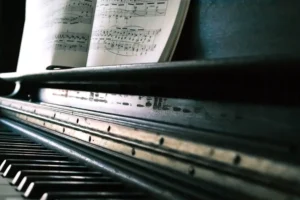The Ionian mode is the backbone of Western music. Bright, happy and melodic, it’s a key ingredient in countless compositions, from timeless classical pieces to contemporary pop hits. Whether you’re just beginning your piano journey or looking to deepen your understanding of music theory, mastering the Ionian mode is a fantastic step forward.
In this article, we will unravel the mysteries of the Ionian mode, its relationship to the major scale, and how you can use it to elevate your piano playing. We’ll also provide charts and practical tips for incorporating this mode into your practice.
- Fall in love with the music - Learn your favorite songs, at a level suitable for you.
- Enjoy interactive piano lessons - Explore courses covering music theory, technique chords & more.
- Get real-time feedback - Skoove's feedback tells you what went well and what needs practice.

What is the Ionian mode?
The Ionian mode, synonymous with the major scale, is a cornerstone of Western music and a must-know for any aspiring musician. If you’ve ever played a major scale, you’ve already encountered it.
However, its significance goes far beyond its familiarity. Originating in ancient Greece, where music intertwined with philosophy and mathematics, the Ionian mode had a humble beginning. During the medieval period, it took a backseat to modes like Dorian and Aeolian, which dominated early church music.
It wasn’t until the Renaissance that the Ionian mode rose to prominence, becoming a foundational element of Western musical tradition. Today, its versatility and melodic appeal make it a staple in both classical, jazz and pop music, unlocking endless creative possibilities for musicians.
The Ionian mode is defined by its interval pattern:
W-W-H-W-W-W-H
(H = Half Step, W = Whole Step)
This sequence of intervals creates the sound that gives the mode its character.
Let’s break down the Ionaian mode formula with an example. If we start on C, the Ionian mode (or C major scale) consists of the following notes:
C-D-E-F-G-A-B-C

Unlike some other modes that might lean toward tension or melancholy, the Ionian mode feels stable and satisfying as it is built on the first degree of the major scale, hence the similarity.
This stability is why the Ionian mode is so versatile. It’s the mode of choice for melodies, harmonies, and chord progressions that aim to evoke happiness or optimism.
Ionian mode scales
At its core, the Ionian mode is simply the major scale. It’s built on a sequence of whole and half steps that creates its distinctive bright and happy sound.
While the C major scale (C-D-E-F-G-A-B-C) is the most commonly used example of the Ionian mode, musical modes can start on any of the twelve notes in the chromatic scale. Each starting note creates a new “key” of the Ionian mode, all of which follow the same interval pattern:
W-W-H-W-W-W-H
The structure of the Ionian mode ensures that its bright and melodic character is consistent no matter which key you play it in. For example:
- The G Ionian scale begins on G and follows the pattern G-A-B-C-D-E-F#-G.

- The D Ionian scale starts on D and includes D-E-F#-G-A-B-C#-D.

What changes between keys is the inclusion of sharps (#) or flats (♭) to maintain the same interval structure. These accidentals ensure that the scale adheres to the Ionian mode’s interval pattern.
Here’s a table showcasing the Ionian modes across all 12 keys:
| Mode | Notes |
| C | C-D-E-F-G-A-B-C |
| G | G-A-B-C-D-E-F#-G |
| D | D-E-F#-G-A-B-C#-D |
| A | A-B-C#-D-E-F#-G#-A |
| E | E-F#-G#-A-B-C#-D#-E |
| B | B-C#-D#-E-F#-G#-A#-B |
| F# | F#-G#-A#-B-C#-D#-E#-F# |
| C# | C#-D#-E#-F#-G#-A#-B#-C# |
| F | F-G-A-Bb-C-D-E-F |
| Bb | Bb-C-D-Eb-F-G-A-Bb |
| Eb | Eb-F-G-Ab-Bb-C-D-Eb |
| Ab | Ab-Bb-C-Db-Eb-F-G-Ab |
As you practice, platforms like Skoove can be invaluable for guiding you through each key with interactive exercises and feedback. The step-by-step approach ensures you’re not just memorizing notes but truly understanding piano scales.
How to play the Ionian mode on piano?
Playing the Ionian mode on the piano is simpler than you might think. Let’s break it down into easy-to-follow steps:
Start with C major (C Ionian mode):
- Place your right-hand thumb (finger 1) on middle C.
- Use this finger pattern: 1 (C), 2 (D), 3 (E), thumb under to 1 (F), 2 (G), 3 (A), 4 (B), and 5 (C).
- Reverse the motion to descend back to the starting note.
- Practice until the motion feels smooth and natural.
Add the left hand:
- For the left hand, start with your pinky (finger 5) on the low C.
- Use the finger pattern: 5 (C), 4 (D), 3 (E), 2 (F), thumb (1) for G, cross over with 3 (A), 2 (B), and 1 (C).
- Practice ascending and descending until you can play with ease.
Explore other keys:
- After mastering C major, move to G major (G ionian). The notes are G-A-B-C-D-E-F#-G.
- Follow the same interval pattern (W-W-H-W-W-W-H) and adjust fingerings for any sharps or flats.
Combine both hands:
- Start slowly, playing one note at a time with both hands.
- Once comfortable, try increasing your speed. Focus on accuracy rather than speed at first.
Once you’ve mastered the basics:
- Explore the experiment with rhythms like triplets or syncopation.
- Practice dynamic contrasts from soft to loud.
- Create simple melodies over a Ionian chord progression.
One of the challenges of learning modes is ensuring you’re practicing correctly and consistently. That’s where Skoove comes in. Skoove offers interactive lessons that guide you step by step through scales and modes, including the Ionian mode. Whether you’re working on piano for beginners, hand coordination, improvisation, or exploring Ionian mode scales in different keys, Skoove provides tailored exercises and real-time feedback. This makes the process not only efficient but also engaging.
Top 3 songs to play with Ionian mode
The Ionian mode is the foundation of countless iconic melodies. Its bright, uplifting sound makes it a favorite for creating memorable tunes across genres. Here are three great songs you can learn with Skoove to explore the beauty of the Ionian mode while enhancing your piano skills!
1. Clair De Lune – Claude Debussy
This timeless piece uses the Ionian mode, characterized by its bright and harmonious major scale. The elegant melodic phrasing and lush chords highlight the Ionian mode’s uplifting, serene quality.
2. Air on the G String – Johann Sebastian Bach
Bach’s masterpiece beautifully showcases the Ionian mode with its serene and flowing melodic lines.
3. No Woman No Cry – Bob Marley
This reggae classic features the Ionian mode, pairing uplifting harmonies with heartfelt lyrics.
Conclusion
Once you’ve mastered the Ionian mode, you’ll see its influence everywhere. Use it in songs you know or as a framework for writing cheerful melodies and uplifting harmonies. Regular practice, with tools like Skoove, will help you build a solid foundation for your musical journey. Sit at your piano, explore the Ionian mode, happy practicing!
Author of this blog post:
Susana Pérez Posada

With over seven years of piano education and a deep passion for music therapy, Susana brings a unique blend of expertise to Skoove. A graduate in Music Therapy from SRH Hochschule Heidelberg and an experienced classical pianist from Universidad EAFIT, she infuses her teaching with a holistic approach that transcends traditional piano lessons. Susana’s writings for Skoove combine her rich musical knowledge with engaging storytelling, enriching the learning experience for pianists of all levels. Away from the piano, she loves exploring new places and immersing herself in a good book, believing these diverse experiences enhance her creative teaching style.
Published by Lydia Ogn from the Skoove team















